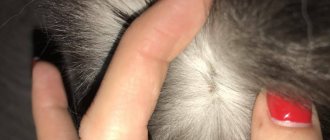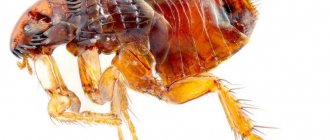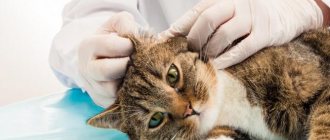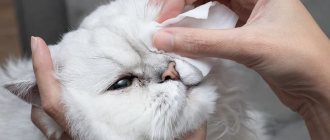Even indoor cats that never go outside or have contact with other animals can become infected with various parasites that live, reproduce and feed on the surface of the body.
The most common insects that like to hide in thick fur are fleas. They are brought into the house in various ways, including on a person’s clothes and shoes. They cannot be noticed immediately: they are so small and move quickly. Therefore, every pet has a risk of becoming infected with fleas.
It is important to know whether fleas can spread to humans and what potential danger they pose.
Features of parasitism
Each animal has its own variety of fleas. And they settle only on a specific pet, feeling good there: the body temperature suits them, as well as the composition of the blood, the thickness of the coat.
But at the same time, insects normally tolerate negative conditions for them and can even starve for up to a month. Moreover, if another type of animal is nearby, they can use it for food and temporary shelter, as well as for movement. Fleas are very unpretentious “people”.
The "cat" type of flea is called Ctenocephalides Felis. This is literally translated from Latin as “cat flea”. These are precisely the parasites that settle in the fur of domestic furry animals and begin to actively multiply there. It is worth remembering that “dog” fleas can easily spread to a cat if there are different pets living in your house.
How to treat flea bites
Treatment of cat flea bites is usually symptomatic and involves the following procedures:
- wound disinfection. Even a microscopic puncture of the skin is a violation of its integrity, so the bite area is treated with an antiseptic. You can use whatever is at hand (hydrogen peroxide, iodine, alcohol, chlorhexidine, etc.);
- relieving itching and swelling. To do this, use special formulations designed for situations with insect bites, for example, Fenistil Gel, Psilo-Balm, etc. To combat swelling, you can apply a piece of ice wrapped in a cloth.
If after a flea attack there is a serious reaction with fever and general weakness, then you should immediately consult a doctor to prescribe the correct treatment.
How does the insect behave?
She spends a huge part of her life in landfills, in the grass, in the nests of birds and animals, she can live in basements, and loves dampness.
Pets are used only for food and reproduction. She jumps onto the animal’s body, bites it several times, drinks the blood, and after satiation returns to her “home.” Despite the unique ability to starve for a long time, fleas cannot develop and reproduce without food.
One flea can lay up to 500 eggs in its lifetime. These eggs are almost invisible, they are smooth and very small. They accumulate in the bed where the cat rests, or remain in her fur. After 6–10 days, the first larvae appear and begin to feed in the same way as adults. At the same time, they also do not live on fur, but move to the dark corners of an apartment or house, where they develop, pupate and turn into adult fleas.
Dangerous diseases after flea bites
Fleas create the preconditions for the development of 2 dozen diseases, being carriers of bacteria, viruses, protozoan microorganisms, and intracellular parasites.
Bacterial infections
The following pathologies can develop after flea bites:
- Plague. It is caused by the plague bacillus, a gram-negative bipolar coccobacilli. The disease is accompanied by damage to the lymph nodes, lungs, and other internal organs, the development of sepsis and an extremely difficult general condition of the patient;
- Pseudotuberculosis. Caused by gram-negative mycobacteria. Manifested by fever, general intoxication, damage to the liver and small intestine, a massive rash throughout the body;
- Intestinal yersiniosis. It is provoked by the bacillus Yersinia enterocolitica. As part of the development of the pathological process, the gastrointestinal tract, liver, and cardiovascular system are affected, and a negative effect on the central nervous system is observed;
- Pasteurellosis. Caused by the Gram-negative, non-motile ovoid microorganism Pasteurella multocida. An infected person develops fever, intoxication, inflammatory processes on the skin, creating the preconditions for the development of arthritis and osteomyelitis;
- Brucellosis. It is provoked by gram-negative protobacteria of the Brucella family. With brucellosis, granulomas form in the lymph nodes, carried by the peripheral bloodstream to the internal organs of a person, which causes their failure;
- Listeriosis. Caused by the gram-positive rod-shaped bacteria Listeria. First of all, a person’s central nervous system is affected, meningitis and encephalitis develop, which leads to death if medical care is not provided.
Intracellular parasitic infestations
Fleas are carriers of rickettsiae, polymorphic rod-shaped, non-motile, gram-negative cell structures. They attach themselves to living cells of the human body and parasitize in their cytoplasm and nucleus.
Protobacteria provoke the development of typhus. The disease is characterized by a rash throughout the body, severe fever, and disruption of the cardiovascular and nervous systems.
Such intracellular parasitic invasions lead to the rapid development of complications - thrombophlebitis, endotheritis, pulmonary embolism, cerebral hemorrhages, and secondary bacterial infections. If medical care is not provided with the mandatory use of anticoagulants and tetracyclines, death occurs.
Viral infections
Fleas are typical carriers of tick-borne encephalitis and hepatitis viruses:
- Tick-borne encephalitis. The initial stage of the disease is manifested by severe intoxication and fever with increased body temperature. Over time, the virus creates the preconditions for damage to peripheral nerves, the formation of muscle rigidity, and hallucinations. Often the patient experiences psychomotor agitation, convulsions, and epileptimorphic seizures. The final stage of the pathology is coma and death in the absence of intensive care;
- Hepatitis. Acute liver inflammation. It is a consequence of the penetration of viruses into the organ. Fleas are carriers of hepatitis B and C types.
Infections with eukaryotes and protozoa
Ectoparasites can act as carriers of a paraphyletic group of protists - organisms belonging to eukaryotes. The consequence of invasion is the formation of hemogregarinosis and trypanosomiasis.
- Hemogregarinosis. Caused by the Adeleida family of spore protozoa. Provokes a complex disruption of the cardiovascular system;
- Trypanosomiasis. Caused by parasitic unicellular organisms of the trypanosomatid family. It provokes the development of a wide range of diseases, in particular “sleeping sickness” and Chagas syndrome.
Are cat parasites transmitted to humans?
Many pet owners wonder whether cat parasites can spread to humans.
The cat flea is not very fond of human skin, although it bites when there is no other “victim” nearby.
It will not live or reproduce on the body, since the temperature in humans is lower than that needed by the insect for metabolism and normal existence. And the cat’s temperature is approximately 38–39 °C, which is very comfortable for a flea.
The difference in temperature is quite large, and we also have thicker skin than a pet. Thus, the question of whether parasites are transmitted from cats to humans can be answered in the negative. But sometimes insects cause trouble: the bitten areas are very itchy.
The danger of fleas to humans
Although parasites do not stay on the body, they are extremely dangerous to health. It is recommended to understand exactly how they can harm a person. It is important to understand that they are carriers of infections, which is why you need to immediately get rid of dangerous parasites. There is no doubt about whether ordinary cat fleas bite people.
Bloodsuckers cause the following health problems
- Dermatitis. The skin will become very inflamed, red and begin to itch. The more bites, the more severe the health situation will be.
- Anthrax. Severe damage to internal organs, in which ulcers form on the body and severe blood loss is observed.
- Erythema. Ulcers appear on the dermis, which gradually peel off and die. The patient's skin becomes noticeably pale, indicating health problems.
- Fever. The body is severely intoxicated, the liver and other internal organs are affected. A severe rash is observed on the body, which can be confused with hives.
- Brucellosis. It is transmitted by blood-sucking parasites, which causes the entire body to be affected and hyperthermia to occur. If treatment is not started in a timely manner, death will occur.
- Severe allergies. Many people have an allergic reaction to insect saliva. Breathing becomes impaired, body temperature rises, and the rash worsens. If measures are not taken, then anaphylactic shock will occur, which is extremely dangerous to health.
Other dangerous diseases such as hepatitis, encephalitis, typhus and salmonella virus are also transmitted to people. For this reason, it is important to combat parasites if they are found in a pet. If there are too many of them, then everyone living in the apartment will have to suffer from the problem and constantly find multiple bites on the dermis. It can be recommended to follow certain tips in order to avoid encountering bloodsuckers in the future.
Can they live on the human body?
Fleas are blood-sucking insects. They settle on the animal’s body when they are hungry and begin to drink blood by sucking on the skin. However, it doesn’t matter to them whether it’s a person or a pet, they bite everyone the same way. It is believed that fleas cannot live on humans and bite them accidentally. But there is also a myth that fleas live in a cat’s fur and never leave their “house.” But is it?
In fact, flea larvae and even adults do not live permanently even on the body of an animal. They find a home not far from the place where the pet spends a lot of time. Most often this is bedding, carpet, soft bed, as well as furniture.
Fleas very often live in basements, and then begin to spread throughout the first floor. And if you don’t protect your pet in time by using preventive measures, then very soon fleas will begin to annoy him with bites.
From this we can conclude that not all types of such insects live in a pet’s fur. And even more so, they will not live on humans. The flea can remain in a fold of clothing for some time, but, having saturated itself with blood, it leaves its victim. There is nowhere to hide on the human body, since he does not have thick hair, so parasites will never choose it as a permanent habitat.
What do cat fleas look like?
There are more than 2 thousand species of blood-sucking fleas, and one of the most common varieties is the cat parasite (ctenocephalides felis). They have a body flattened on the sides with spines and bristles that allow them to be held in the fur. The dimensions are miniature - an adult is about 2 mm in length, and in a well-fed state it can reach 4 mm. The color of the body is dark brown, with a slight gloss. Fleas do not have wings, but their very long hind legs allow them to make long jumps. An ordinary person is not able to identify the differences between cat fleas and dog, rat or other varieties; only an entomologist with special equipment can do this.
Cat fleas are very small in size - about 2 mm when hungry.
The piercing-sucking type of mouthparts is the main instrument for extracting blood necessary for the life support of the insect. Fleas need blood at all stages of their life cycle; even larvae feed on the feces of adult insects, which contain blood. Hungry individuals are not able to mate; without blood sucking, neither sexual development, nor reproduction, nor feeding of offspring is possible. One of the differences between fleas and other blood-sucking parasites is that during the bite they do not inject any anesthetic substances into their victim.
Are these insects dangerous for the animal owner or not?
It is very important to know how dangerous fleas are for a pet owner who has become ill with parasites. Common bite marks are not harmless: they can have serious consequences:
- Allergy. Usually occurs in people who are prone to similar reactions and often suffer from various irritants. Allergic dermatitis appears on hypersensitive skin. In this case, the allergen is the flea's saliva, which will cause the bitten area to itch for a long time.
- Infection with worms. Parasites are carriers of nematodes, as well as helminths. As a result, dipilidia may develop, during which tapeworms begin to develop in the body. Their largest size in the intestine is 70 cm.
- Bartonellosis. This is a whole group of diseases that differ from each other, but the source of their occurrence is the same - bacteria carried by fleas. All of them pose a potential danger to humans.
All these diseases can be contracted not only at home if your pet catches fleas. But insects can also bite in the entrance, on the street, when interacting with street animals and even with pets.
Fleas can appear in an apartment very easily: you can bring them on shoes or clothes along with dirt.
It is also worth remembering that fleas are capable of giving rise to entire epidemics, which has already happened more than once: they are carriers of typhoid and plague. Therefore, we must not forget about prevention: check your pet as often as possible for the presence of these unpleasant and dangerous insects.
Where can a cat get fleas?
Cats can get fleas from anywhere. It is enough to let him out for a short time, and he will return not only dirty and smelly, but also with a handful of large, adult, very hungry fleas.
The most common breeding ground for these parasites is:
- infected animals;
- sleeping mats, cat houses and beds that have already been used by infected animals;
- wild animals (mice, rats, moles, hedgehogs, foxes, badgers, etc.);
- livestock farms, especially fur farms and rabbit farms;
- places heavily infested with fleas, basements;
- forests, fields, meadows, woodlands.
Signs of bites
Flea bites are quite noticeable and unpleasant. It is very important to learn to recognize them in order to begin disinfection in time. After all, insects will not go away on their own: they multiply very quickly and begin to live in:
- cracks;
- carpets;
- sofas;
- bedding.
Here are some obvious signs that you have been bitten by a flea:
- At the moment of the bite, you will feel a prick on your skin, which is much more painful than a mosquito bite.
- Later, red dots may be seen on the skin. Sometimes the blisters swell and the skin around them turns red.
- The affected area is very itchy, causes a lot of trouble and constantly reminds you of itself.
- The bites are approximately 1–2 cm apart. But these are not straight paths, as happens if bedbugs live in the house.
- Insects usually bite legs, since their jumps do not exceed half a meter. But if they settled in the bed or jumped into it, they can bite the whole body.
Depending on the sensitivity of the skin and the characteristics of the human body, the marks after bites can be different: small, invisible or blurred, very large. But they will still disappear in a few days, so there is no need to be afraid.
Prevention measures
To avoid flea control and protect yourself and your pet from bites, you need to know preventative measures and ways to get rid of fleas.
If we talk about cat fleas simply, then they feel very comfortable not only on cats. Whether you live in a cozy apartment in an apartment building or in a country kiosk, cat fleas are equally comfortable around your furry pets.
The first step is to protect your pets. There are many proven means for this:
- insecticidal shampoos;
- anti-flea drops;
- pills;
- flea collars.
It is important to remember that flea control must be coordinated with deworming. Detailed advice can be obtained at any veterinary clinic.
Depending on the drug chosen, your pet’s lifestyle and where it is kept, treatment can be carried out every 3-6 months as part of ongoing preventative care. Even a cat that doesn't go outside can become infected with parasites, for example, from a neighbor's animal or from a stairwell. Without realizing it, you may find flea larvae on your shoes and then wonder where they came from.
The second stage of prevention is no less important. It refers to the treatment of domestic animal habitats. There are many different means for this: repellent sprays, solutions, emulsions and liquid detergents.
Wash your cat's bedding and other favorite soft objects that may harbor flea eggs. If possible, steam them in a home steamer at maximum temperature and treat them with a store-bought product. Wash all floors, disinfect bedspreads and carpets in the apartment.
How to fight?
How to rid your pet of annoying parasites? There are several effective ways:
- Shampoo. You can buy a special shampoo that kills fleas. It contains insecticides that do not leave insects the slightest chance. The product is used as usual, which is used for regular washing: applied to the wool, foaming well with your hands. Then you need to wait a little for the composition to take effect and rinse off. Shampoos are good because they prevent relapses: fleas will not return in the near future.
- Collar. It is more of a preventive remedy that repels insects that want to feed on the animal’s blood. The disadvantage of using it is that the collar does not destroy fleas that already live on the cat.
- Drops. An inexpensive and effective remedy that allows you to get rid of parasites in a short time. The drug purchased at a veterinary pharmacy is dripped onto the withers or any other inaccessible place on the animal’s body so that it does not lick off the substance. Soon the substances spread throughout the epidermis, accumulate inside and have a detrimental effect on fleas.
- Spray. It has the same effect as drops. It differs in the method of application: the owner sprays the composition over the skin and fur of the animal. You need to make sure that the cat does not lick itself for a while until the spray dries. This product is also applicable to bedding, carpets, and household items in which cat fleas live.
Remember that by ridding an animal of parasites, you do not protect it from re-infection.
After all, very often fleas accumulate in an apartment, and wet cleaning only multiplies - they love high humidity. Even frost does not scare them. Therefore, after treating a flea-bearing cat, you need to take care of the apartment: disinfect it with special means. But many of them are toxic, so after the procedure it is advisable to leave for a while and take your pet with you.
Cat fleas do not live on humans, but they can cause a lot of trouble and trouble in the form of bites.
If you notice that your animal is itching frequently, examine it and take action if you find signs of flea bites. The sooner you do this, the easier it will be for you: removing a small number of parasites that have not yet had time to reproduce is not as difficult as using countermeasures for an entire nursery.
Don't forget about prevention - let your cat wear an anti-flea collar, and then the risk of becoming infected with parasites will be reduced to zero.
Causes of infection
Unfortunately, pets bring not only positive emotions, but also some troubles, such as parasites living in fur. In the absence of food sources, they are capable of moving onto people. Fleas are transmitted from cats to humans very often; when the first signs of infection appear, it is important to quickly respond and take action by choosing products that are safe for your pet.
Pests are distinguished by high endurance and the ability to quickly adapt to a new habitat. A cat can become infected with fleas in a variety of ways. Parasite larvae are resistant to unfavorable conditions. Young individuals can live without a host; they do not need blood at an early age.
The danger fleas pose to cats is described in the video:
A cat can become infected in the following ways:
- On a walk. All an animal needs to do is walk on the grass, lie down on a bench, or run on the sand: there are larvae everywhere.
- Fleas can be transmitted from cats to humans, and from humans to furry pets. If the owners visit and pet a flea-covered cat, the parasites can get on their clothes and shoes. This way the pests will move to another house. Larvae can be found not only on your pet’s fur, but also on any things. Therefore, when visiting, you should be careful.
- The mother can infect the kitten. From her, parasites can be transmitted to an entire brood. Experts advise treating your pet before lambing to prevent such a problem.
- Rodents are also carriers of insidious bloodsuckers. When a cat hunts, it can easily become infected with fleas from them.
Animals can become infected with parasites while walking or through contact with an infected animal.
Signs of the presence of parasites in an animal
Fleas on a cat cause him discomfort. The animal, with its restless behavior and constant scratching, will make it clear that it needs help. By spreading the hairs of the fur with your hands, you can see the presence of “guests”.
Other signs:
- the animal constantly bites itself and tries to catch the parasite;
- red dots are visible on the pet’s body;
- on the pet's resting place or on its rug, you can see parasite feces - they look like small dark dots.
How to remove fleas from a cat and from the premises?
How to get rid of fleas on a cat and eliminate them from your living space? In order for the liquidation to be successful, all actions must be performed comprehensively from the very beginning and possibly repeated more than once.
The fight includes the following steps:
- It is necessary to close all windows and doors in order to treat the home with the intended products. All corners and hidden places under the furniture (the furniture itself too) should be treated with anti-flea aerosols, and carpets and bedspreads should be cleaned and preferably fried in the sun.
- It is necessary to use flea products for cats to treat the cat's bedding and all places that the pet has chosen. In a private home, do not forget about the grass and the yard.
- Apply an effective remedy for fleas on cats to the mustache.
- Carry out general cleaning of the home using insecticides.
When choosing a flea treatment for cats, you should pay attention to the effectiveness of the chemicals in the composition and their quantity. It is also worth studying customer reviews. Effective preparations contain celandine, which in combination with other ingredients causes paralysis in the parasite.
You can remove microparasites by using flea drops for cats, which are distributed over the withers of the victim, or you can use sprays. Dripping or spraying the drug must be done carefully so that the chemical does not get into your pet’s eyes.
The next method by which you can remove fleas is injections, which should be done once every six months.
For a short period, which is very convenient when moving, an anti-flea tablet will protect the animal (it is valid for 1 month).
Life cycle of an insect
To know what to expect from parasites, you need to do a little research into their lives. Then the issue of danger, the possibility of human infection, will be resolved.
- Fleas go through several stages of development. The larva differs significantly from the adult in appearance, lifestyle, and nutrition. Optimal conditions for the reproduction and existence of parasites are temperatures in the range from 20 to 30 degrees Celsius, humidity within 60%. Lower and higher temperatures are detrimental to fleas.
- Flea eggs no more than 0.5 mm. White. They can only be noticed if there is a significant accumulation in one place. Fleas do not form nests; they lay eggs wherever they can. A large number of eggs look like scattered sand.
- The female needs food to lay eggs. The source is animal blood. The insect literally shoots an egg out of itself, which falls away from itself, or rolls down the cat's fur onto the floor. The female lays from 5 to 15 pieces per day.
- The larva develops in the egg for about 2 weeks. It is born as a white worm 1 mm long. In 20 days, the flea larva goes through 3 molts, each time increasing in size. At the last stage it pupates, after 2 days a full-fledged flea appears, ready for mating.
- The larvae live under animal bedding, rugs, near the toilet, as well as in the apartment under flower pots, boxes of vegetables, near the toilet, under the trash can. They feed on waste, excrement, and skin particles.
What do we know about fleas?
The flea is a blood-sucking ectoparasite, characterized by its small size (on average 1-5 mm, but there are larger exceptions) and also its phenomenal jumping ability. The color of the chitinous exoskeleton of this jumper varies from classic brown to deep black.
The habitat of fleas is incredibly large. These small bloodsuckers can be found even in the snows of the Arctic.
Fleas are not picky in choosing a host. They are able to parasitize all warm-blooded creatures, especially cats and dogs due to their thick fur. They are not found only in fish and various amphibian-reptiles.
Since the community of warm-blooded animals is very diverse, including the class of birds, fleas for each species have some differences in appearance. But the fundamental signs are the same for everyone. Based on them, zoologists classified all flea families into one order.
Folk remedies for fleas
Opponents of chemical drugs can rid a cat of fleas using folk remedies. It is important to understand that the first time will not have the desired effect; it will take at least a week of patiently treating your pet with the following remedies.
What to do?
- Use decoctions for baths and external compresses (celandine, tansy, wormwood in equal proportions - take a mixture of dry herbs - 20 g for 2 glasses of water).
- Use salt solutions as compresses (it is good to dilute the salt in the decoction where the celandine was cooked).
- Crush 3 cloves of garlic, pour in 3 glasses of water and leave to brew overnight. Use as drops, distributing the liquid along the animal’s withers.
Many people, especially those with small children, are afraid of the composition of insecticidal preparations, so rather than using chemicals to remove fleas from a cat, it is better to use a folk alternative.
To prevent the eliminated microparasite from returning, the cat needs to carry out preventive measures - periodically use anti-flea drugs or bathe it in herbal decoctions. If your pet likes to walk outside, you should use a flea collar.
External characteristics of the parasite
Fleas are Lilliputian insects. A person with poor eyesight is unlikely to see them, because the color of their body is an inconspicuous brown shade, and their length does not exceed 2 mm. Microscopic external parameters allow these creatures to jump from place to place without much effort.
It is possible to detect the parasite under the fur of an animal, but you will have to fine-tune your vision. But even after seeing it, it will be quite difficult to overcome the micro-creature, for example, crush it with your fingers, since their body is “protected” by a super-strong shell of chitin.
There are different types of fleas, but they are all identical at first glance. Cat fleas are very similar to human fleas and the differences between them can only be seen by a specialist using a special magnifying device.
To understand how to deal with fleas in cats, it is important to be able to distinguish them from ticks; the latter has 8 legs, while fleas have 6.











